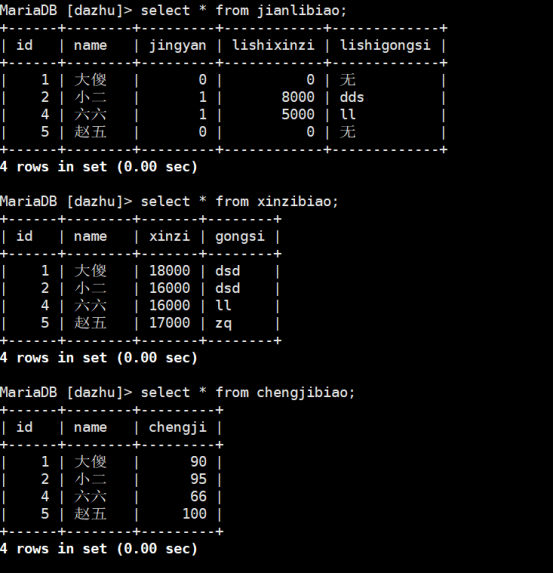mysql数据库中表格的联合查询
多表联合查询
1. 环境准备:

备注:三个表中至少有一个字段相同(字段表内信息可不完全一致,顺序也不必相同),从而起到三个表格相连的作用
2. 多表联合查询方式:
语法格式:select 标记1.字段名,标记2.字段名,标记1.字段名,标记3.字段名 from 表名1 标记1 ,表名2 标记2,表名3 标记3 where 标记1.字段名=标记2.字段名 and 标记1.字段名=标记3.字段名;
MariaDB [dazhu]> select c.id,c.name,c.chengji,j.jingyan,x.xinzi,x.gongsi from chengjibiao c,jianlibiao j,xinzibiao x where c.id=j.id and c.id=x.id;

3.多表联合查询,同时为字段设置as别名:
语法格式:select 标记1.字段名,标记2.字段名 as 别名A,标记1.字段名 as 别名1,标记3.字段名 as 别名c from 表名1 标记1 ,表名2 标记2,表名3 标记3 where 标记1.字段名=标记2.字段名 and 标记1.字段名=标记3.字段名;
MariaDB [dazhu]> select c.id as '编号',c.name,c.chengji,j.jingyan,x.xinzi,x.gongsi as '单位' from chengjibiao c,jianlibiao j,xinzibiao x where c.id=j.id and c.id=x.id;
##这样,id和gongsi字段名就会分别被显示为‘编号’和‘单位’
4.多表联合查询,外连接:
一、左连接;
以左边表格为主,包含所有左边表中的记录甚至是右边表中没有和它匹配的记录。因此可以用于查询未产生第二表格数据的第一表格内的元素信息!
基本格式:select 字段/* from 左表 left 右表 on 左表字段=右表字段;
二.右连接
以右边表格为主,包含所有右边表中的记录.
基本格式:select 字段/* from 左表 right 右表 on 左表字段=右表字段;
实例:
以左边为主
select * from xueyuanbiao left join xinzibiao on xueyuanbiao.id = xinzibiao.id;
##出了可以查看学员就业情况之外,还可以查询出哪个学员没找到工作
MariaDB [dazhu]> select c.id as "编号",c.name,c.chengji,x.name,x.xinzi as "biao c left join xinzibiao x on c.id=x.id; +--------+--------+---------+--------+--------+ | 编号 | name | chengji | name | 薪资 | +--------+--------+---------+--------+--------+ | 1 | 大傻 | 90 | 大傻 | 18000 | | 2 | 小二 | 95 | 小二 | 16000 | | 4 | 六六 | 86 | 六六 | 16000 | | 5 | 赵五 | 100 | 赵五 | 17000 | | 6 | 宇宇 | 73 | NULL | NULL | | 3 | 明明 | 80 | NULL | NULL |可以发现宇宇和明明可能还未找到工作; +--------+--------+---------+--------+--------+ 6 rows in set (0.00 sec) 以右边为主 MariaDB [dazhu]> select c.id as "编号",c.name,c.chengji,x.name,x.xinzi as "biao c right join xinzibiao x on c.id=x.id; +--------+--------+---------+--------+--------+ | 编号 | name | chengji | name | 薪资 | +--------+--------+---------+--------+--------+ | 1 | 大傻 | 90 | 大傻 | 18000 | | 2 | 小二 | 95 | 小二 | 16000 | | 4 | 六六 | 86 | 六六 | 16000 | | 5 | 赵五 | 100 | 赵五 | 17000 |只看找到工作的学员的曾经成绩; +--------+--------+---------+--------+--------+ 4 rows in set (0.00 sec)
三.子查询
有时候,当我们查询的时候,需要的条件是另外一个select语句的结果,这时就需要使用子查询。
用于子查询的关键字包括in、not in、=、!=、exists、not exists等
基本语法 :select 字段 from 表名 where 字段 in(条件(可以是字段元素也可以是select语句从其他表提取内容!))
实例:
MariaDB [dazhu]> select * from chengjibiao where id in(select id from xinzi ##先提取xinzibiao中的ID内容让后作为提取成绩表内容的条件id的参数!(可以理解为仅仅在成绩表一个表中偷取内容) +------+--------+---------+ | id | name | chengji | +------+--------+---------+ | 1 | 大傻 | 90 | | 2 | 小二 | 95 | | 4 | 六六 | 86 | | 5 | 赵五 | 100 | +------+--------+---------+ 4 rows in set (0.00 sec) MariaDB [dazhu]> select * from chengjibiao where id not in(select id from xinzibiao); +------+--------+---------+ | id | name | chengji | +------+--------+---------+ | 6 | 宇宇 | 73 | | 3 | 明明 | 80 | +------+--------+---------+ 2 rows in set (0.00 sec)
......同理,select * from chengjibiao where id = 1;
四、记录联合;
使用 union 和 union all 关键字,将两个表的数据按照一定的查询条件查询出来后,将结果合并到一起显示。
两者主要区别在于:union去重;union all 不去重,全部显示
实例:
MariaDB [dazhu]> select chengji from chengjibiao union all select xinzi from xinzibiao; +---------+ | chengji | +---------+ | 90 | | 95 | | 86 | | 100 | | 73 | | 80 | | 18000 | | 16000 | | 16000 | | 17000 | +---------+ 10 rows in set (0.00 sec) MariaDB [dazhu]> select chengji from chengjibiao union select xinzi from xinzibiao; +---------+ | chengji | +---------+ | 90 | | 95 | | 86 | | 100 | | 73 | | 80 | | 18000 | | 16000 | | 17000 | +---------+ 9 rows in set (0.00 sec)


